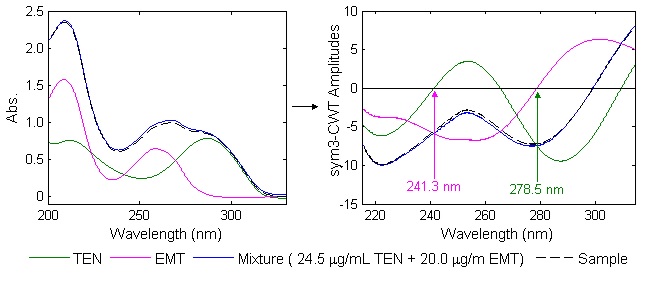Wavelet Signal Processing Tools for Quantifying and Monitoring the in-vitro Dissolution Profiles of Tenofovir Disoproxil Fumarate and Emtricitabine in Tablets
DOI:
https://doi.org/10.29356/jmcs.v66i4.1790Keywords:
Continuous wavelets transform (CWT), emtricitabine, in-vitro dissolution testing, tenofovir disoproxil fumarate, UV derivative spectrophotometryAbstract
Abstract. Wavelet signal processing tools were applied to the UV spectral dataset for the quantification and understanding the in vitro dissolution behaviors of tenofovir disoproxil fumarate (TEN) and emtricitabine (EMT) in commercial tablets with low-cost and short analysis time. Preliminary signal analysis tests were staged to determine the most suitable wavelet family or families to monitor in vitro dissolution profiles and quantify the drugs of interest. Of these, Daubechies (db6), Symlets 3 (sym3), Biorthogonal 1.5 (bior1.5) and Coiflets 5 (coif5) continuous wavelet tools have been found to be optimal as they provide the desired results. Calibration curves obtained by regression analysis of the continuous wavelet signal (dependent variable) on concentration (independent variable) were found to be linear in the range of 4.0-52.0 µg/mL for both drugs. The validity of CWT signal processing tools was tested by analyzing mixtures made in the laboratory. The Quantitation of TEN and EMT by the proposed signal processing tools did not require a pre-separation procedure. They were successfully utilized for the assay and in vitro dissolution monitoring of the two drugs in their combined tablets. Consequently, the presented work provided alternative tools based on wavelet signal processing to traditional derivative spectrophotometry to resolve a two-component mixture without using a priori separation step.
Resumen. Las herramientas de transformada continua de wavelets fueron empleadas para el procesamiento de espectros de absorción UV con el fin de lograr la cuantificación y la comprensión del comportamiento de fumarato de disoproxilo de tenofovir (TEN) y de emtricitabina (EMT) en la disolución in vitro de las tabletas comerciales, con bajo costo y corto tiempo de análisis. Se realizaron pruebas preliminares de análisis de señales para determinar la familia o familias de ondículas más adecuadas para monitorear los perfiles de disolución in vitro y para cuantificar los fármacos de interés. Entre ellos, las herramientas Daubechies (db6), Symlets 3 (sym3), Biorthogonal 1.5 (bior1.5) y Coiflets 5 (coif5) resultaron ser óptimas proporcionando resultados deseados. Funciones de calibración obtenidas mediante el análisis de regresión de señales de ondículas transformadas (variable dependiente) obtenidas para soluciones de calibración (concentración - variable independiente) presentaron buena linealidad en el intervalo de concentraciones 4.0-52.0 µg/mL para ambos fármacos. La validez de procesamiento de señales CWT fue demostrada mediante el análisis de mezclas de conocidas concentraciones, preparadas en el laboratorio. La cuantificación de TEN y EMT no requiere su separación previa. El procedimiento fue empleado en el ensayo de monitoreo de la disolución in vitro de los fármacos y en las tabletas con contenían los dos fármacos. En este trabajo se propone un procedimiento basado en CWT, alternativo respecto a la tradicional espectrofotometría de derivadas para resolución de mezclas binarias sin necesidad de separación previa de dos componentes.
Downloads
References
Wassner, C.; Nicole, B.; Yuman, L. JIAPAC. 2020, 19, 1-10. DOI: 10.1177/2325958220919231. DOI: https://doi.org/10.1177/2325958220919231
Frampton, J.E.; Perry, C.M. Drugs. 2005, 65, 1427-1448. DOI: 10.2165/00003495-200565100-00008. DOI: https://doi.org/10.2165/00003495-200565100-00008
3.Aschenbrenner, D. S. Am. J. Nurs. Sci. 2012, 112, 20-21. DOI: 10.1097/01.NAJ.0000422248.42341.b1. DOI: https://doi.org/10.1097/01.NAJ.0000422249.80459.3b
Joshi, M.; Nikalje, A. P.; Shahed, M.; Dehghan, M. Indian J. Pharm. Sci. 2009, 71, 95-97. DOI: 10.4103/0250-474X.51951. DOI: https://doi.org/10.4103/0250-474X.51951
Anandakumar, K.; Kannan, K.; Vetrichelvan, T. Der. Pharm. Sin. 2010, 1, 52-60.
Rao, B. V.; Vidyadhara, S.; Nagaraju, B.; Jhonbi, S. K. Int. J. Pharm. Sci, 2017, 8, 2168-2176. DOI: 10.13040/IJPSR.0975-8232.8.
Habyalimana, V.; Mbinze, J. K.; Yemoa, C. A. L.; Diallo. T.; Tshilombo, N.K.; Ntokamunda, J. K.; Lebrun, P.; Hubert, P.; Marini, R.D. J. Pharm. Biomed. 2017, 139, 8-21. DOI: 10.1016/j.jpba.2017.02.040. DOI: https://doi.org/10.1016/j.jpba.2017.02.040
Rajesh, S.; Pooja, G. Eurasian J. Anal. Chem. 2009, 4, 276-284.
Rebiere, H.; Mazel, B.; Civade, C.; Bonnet, P. A. J. Chromatogr. Bi. 2007, 850, 376-383. DOI: 10.1016/j.jchromb.2006.12.007. DOI: https://doi.org/10.1016/j.jchromb.2006.12.007
Viswanath, V.; Shanmugasundaram, P.; Ravichandiran, V. Int. J. Pharmtech. Res. 2013, 5, 1186-1195.
Dong, M.W. LCGC North Am. 2013, 31,472–479.
Heba, K.; Ashour, T.; Belal, S. Arab. J. Chem. 2017, 10, 1741-1747. DOI: 10.1016/j.arabjc.2013.06.024. DOI: https://doi.org/10.1016/j.arabjc.2013.06.024
Anindita, B.; Aurobinda, P.; Amit, K. M.; Dannana, G.; Swapan, K. M. S.; Sudam, C. S. Int. J. Pharmtech. Res. 2011, 3,1874-1882.
Choudhari, V. P.; Ingale, S.; Gite, S. R.; Tajane, D. D.; Modak, V. G.; Ambekar, A. Pharm. Meth. 2011, 2, 47-52. DOI: 10.4103/2229-4708.81096. DOI: https://doi.org/10.4103/2229-4708.81096
Dinç, E.; Yazan, Z. Front. Chem. 2018, 6, 503. DOI: 10.3389/fchem.2018.00503. DOI: https://doi.org/10.3389/fchem.2018.00503
Abraham, S.; Golay, M. J. E. Anal. Chem. 1964, 36, 1627-1639. DOI: https://doi.org/10.1021/ac60214a047
Kaiser, G. Continuous Wavelet Transforms. In A Friendly Guide to Wavelets. Birkhäuser Boston: Modern Birkhäuser Classics, 2011, 60-77. DOI: https://doi.org/10.1007/978-0-8176-8111-1_3
Dinç, E.; Ragno, G.; Ioele, G.; Baleanu, D. J. AOAC Int. 2006, 89, 1538-1546. DOI: https://doi.org/10.1093/jaoac/89.6.1538
Walczak, B.; Massart, D. L. Trends. Analyt. Chem. 1997, 16, 451–463. DOI: https://doi.org/10.1016/S0165-9936(97)00065-4


Downloads
Published
Issue
Section
License
Copyright (c) 2022 Erdal Dinç, Nurten Özdemir, Özgür Üstündağ; Eda Büker, Günseli Tilkan; Vu Dang Hoang

This work is licensed under a Creative Commons Attribution-NonCommercial 4.0 International License.
Authors who publish with this journal agree to the following terms:
- Authors retain copyright and grant the journal right of first publication with the work simultaneously licensed under a Creative Commons Attribution License that allows others to share the work with an acknowledgement of the work's authorship and initial publication in this journal.
- Authors are able to enter into separate, additional contractual arrangements for the non-exclusive distribution of the journal's published version of the work (e.g., post it to an institutional repository or publish it in a book), with an acknowledgement of its initial publication in this journal.









